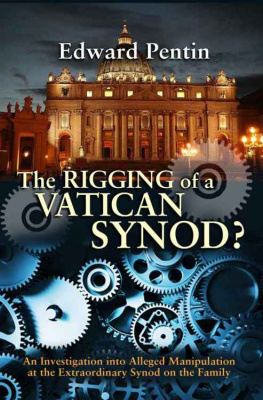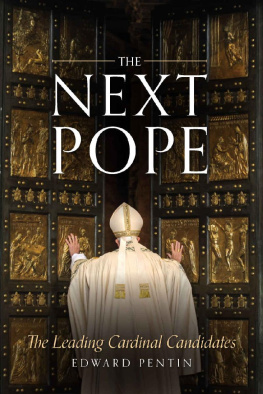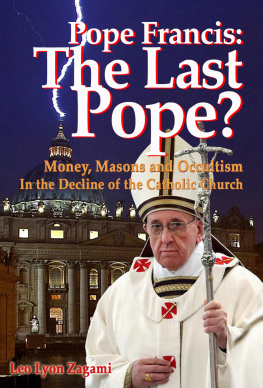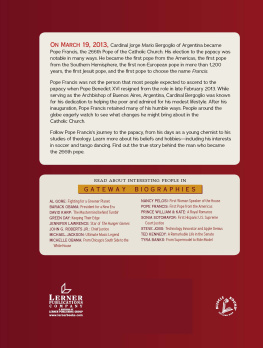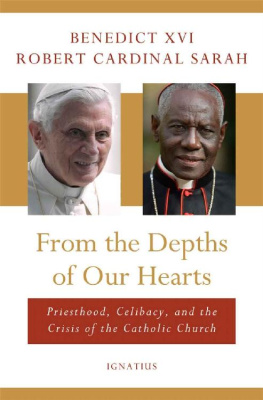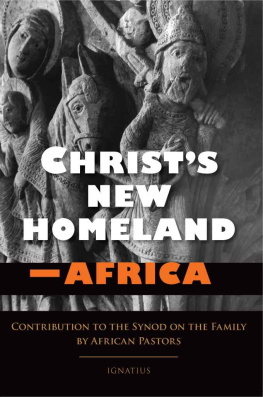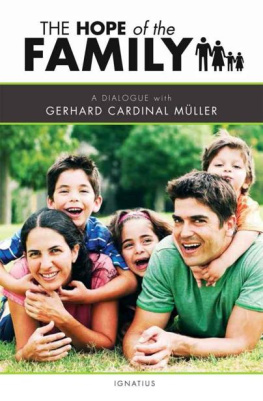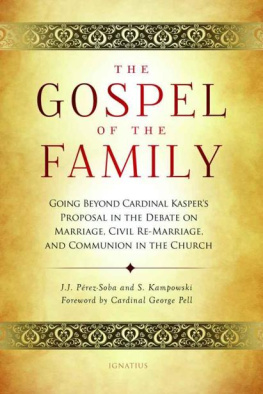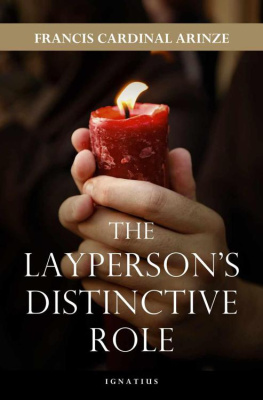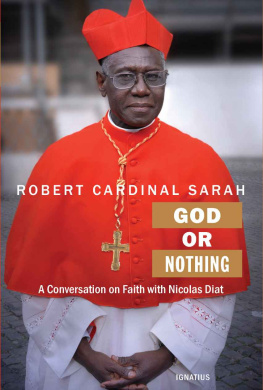The Rigging of a Vatican Synod?
EDWARD PENTIN
The Rigging of a Vatican Synod?
An Investigation into Alleged Manipulation
at the Extraordinary Synod on the Family
An absolutely fascinating account of Synod 2014, especially the machinations surrounding it .
~ Wilfrid Fox Cardinal Napier, Archbishop of Durban,
co-president of 2015 Synod on the Family
IGNATIUS PRESS SAN FRANCISCO
Cover art:
Photograph of Rome taken by Edward Pentin
Old rusty gears @adimas | us.fotolia.com
Cover design by Carl Olson
2015 by Ignatius Press, San Francisco
All rights reserved
ISBN 978-1-68149-678-8 (E)
Printed in the United States of America
To Our Blessed Mother
CONTENTS
ACKNOWLEDGMENTS
This book is the work of many people to whose invaluable assistance I am indebted. Due to the sensitivities surrounding the work, quite a number who helped on it must remain anonymous. I am especially grateful to one contributors inspiring, perceptive, and discerning insights, born out of a sincere devotion to the faith and to the Church.
Similar thanks go to another anonymous contributor for valuable perspectives and input as well as to both Benjamin Harnwell of the Dignitatis Humanae Institute and Kishore Jayabalan of the Acton Institute for their practical help and insightfulness.
I have also been unable to quote many others who helped provide vital information for the book, again due to the controversial subject matter. Among those who can be named, I would like especially to thank Wilfrid Fox Cardinal Napier, Raymond Cardinal Burke, Walter Cardinal Brandmller, Paul Cardinal Cordes, Professor John Rist, Professor Stephan Kampowski, Professor Roberto De Mattei, Father Bernd Hagenkord, S.J., Doctor Austen Ivereigh, Father Stephen Fawcett, and Father Manuel Dorantes.
I am also grateful to the team at Voice of the Family for help with the chronology and their research, particularly the admirable work of Matthew McCusker, whose analysis of the synods final report has been widely praised. My thanks also to Evan Simpkins for helping with research and transcribing a number of interviews.
Finally, I would like to thank the good people at Ignatius Press for their advice, patience, and willingness to take on this project.
INTRODUCTION
Its clear to me that there were individuals who obviously had a very strong influence on the synod process who were pushing an agenda .
Raymond Leo Cardinal Burke, patron of the Sovereign Military Order of the Knights of Malta, LifeSite News , March 24, 2015
This was a rigged synod, I call it the robber synod .
Anonymous Rome priest closely involved in the synod debates, February 2015
At the opening of the Third Extraordinary General Assembly of the Synod of Bishops on the family in October 2014, Pope Francis called for an open and free debate in a bid to help the Church rise to the pastoral challenges facing marriage and the family today, calling on the synod participants to speak boldly and freely, and not to be afraid of what others might think of them.
Such openness and a desire for a free and fair debate was widely welcomed. And yet many felt that the synod that followed didnt turn out like that. Instead it was controversial not only for the subject matter it discussed, but also for the way it was run.
Rather than a free-flowing, fair debate, the dramatic two-week meeting was marred by allegations of manipulation, lies, and dirty tricks.
Furthermore, being exploratory in nature, the 2014 synod provoked criticism in some circles for muddying the waters of doctrine, causing general confusion, and making it appear that key elements of the Churchs teaching were up for grabs.
This book is an attempt to obtain a better idea of what really went on during those somewhat fraught and unseemly two weeks in October 2014. I try to take the reader through the allegations of manipulation aimed at forcing through an agenda by means of aggressiveness and bullying. According to critics, the synod was often administered in such a way as to impede the Holy Spirits action rather than allowing Him to act.
Such tensions and struggles have always been present in the Church, which has always tried to balance truth and mercy while remaining faithful to doctrine. But, given the unsightly infighting shown at the highest levels of the Church during this meeting and the unsavory activities of some involved in the synod, I have wrestled with whether it would be of service to the Church and beneficial to the reader. Journalism demands uncovering the truth in the name of justice, but a tension often exists in Catholic reporting between disclosing sometimes painful and unpleasant truths regarding deeds committed by Catholics, including Catholic leaders, and not wishing to scandalize readers. Many journalists found this to be especially true when covering this meeting.
But after prayer and speaking with ecclesiastical figures and friends devoted to the Church, I came to the conclusion that delving into what went on during the last synod could in some way contribute to helping the next Synod on the Family in October 2015 to be more open, fair, and honest and perhaps closer to the Holy Fathers overall vision.
Although this book contains numerous interviews and extensive research, it is not an exhaustive work, nor does it claim to be completely impartial, although I have striven to be as objective and factually correct as possible.
Chapter 1 contains an analysis of the more serious charges of manipulation of the synod. Chapter 2 lays out the various perceptions of the meeting, beginning with the popes. The principal aim of the chapter is to show what was at stake at the synod on both sides of the debate. It is my hope that the average reader will be able to grasp the meaning and purpose of the meeting.
Chapter 3 takes a look at a leading figure behind the synod, the secretary general of the synod of bishops, the Italian Lorenzo Cardinal Baldisseri, and some of those assisting him. Chapter 4 draws largely on Church historians to look at how the synod compares with the past. The book ends with a chapter containing a chronology of the main evidence pertaining to accusations of manipulation during the meeting.
Due to the sensitivities surrounding this issue, many of those with whom I spoke asked to remain anonymous. However, all of these unattributed quotes are from viable and authoritative sources, either very close to the synod or among the synod participants themselves.
CHAPTER ONE
Evidence of Rigging and Manipulation
The Synods Announced Purpose
Popularly referred to as the Extraordinary Synod on the Family, the meeting was announced by the Vatican with little fanfare on October 8, 2013. The proposed gathering of bishops and experts, which came as a surprise to many, would be held in Vatican City on October 5-19, 2014, on the topic of The Pastoral Challenges of the Family in the Context of Evangelization.
The synod, comprising 253 participants in total, was held in preparation for a larger synod on the same theme of the family in October 2015. Those attending discussed problems facing the family today, including the effects of war, immigration, domestic violence, polygamy, interreligious marriages, cohabitation, the breakdown of marriage, and divorce and civil remarriage.
Pope Francis called the synod because he wanted the Church to move forward together as a community, in reflection and prayer regarding the important aspects of life, particularly the family, under the guidance of the Pope and the bishops.
It was also aimed at providing a solution to certain individuals and episcopates, particularly Germanys, who, for reasons discussed later, wished to go it alone in determining their own pastoral practice on these matters, separate from the universal Church. Such drives toward unique pastoral solutions run the risk of generating confusion, the Vatican said, and it was therefore important that we move forward in full communion with the ecclesial community.
Next page
